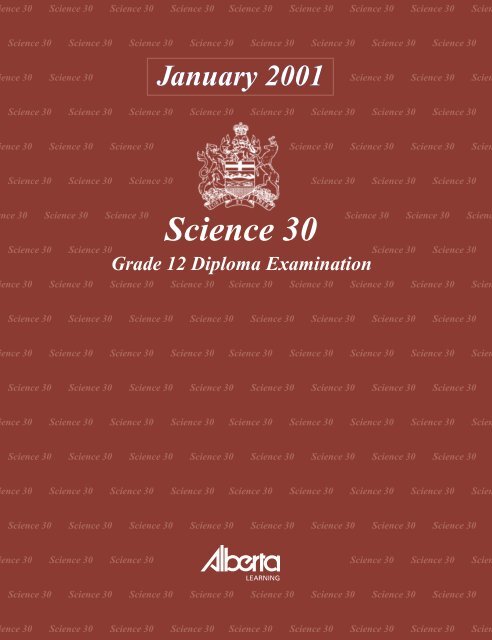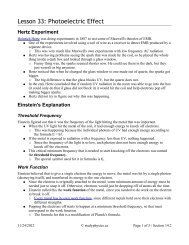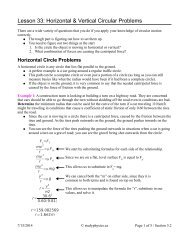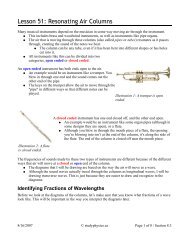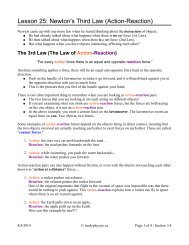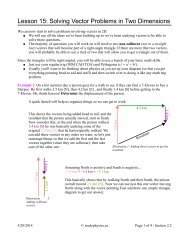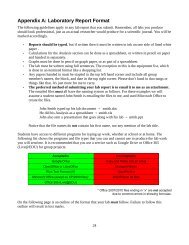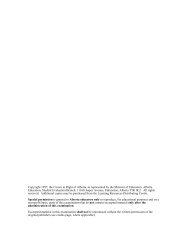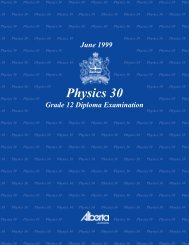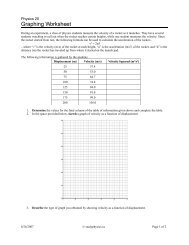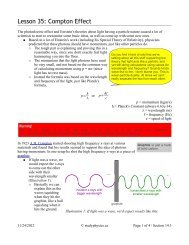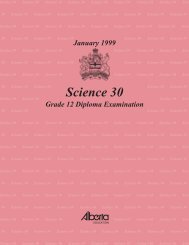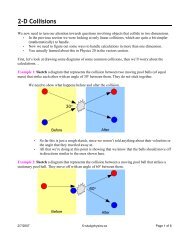Science 30 Diploma Examination January 2001
Science 30 Diploma Examination January 2001
Science 30 Diploma Examination January 2001
- No tags were found...
You also want an ePaper? Increase the reach of your titles
YUMPU automatically turns print PDFs into web optimized ePapers that Google loves.
ence <strong>30</strong> <strong>Science</strong> <strong>30</strong> <strong>Science</strong> <strong>30</strong> <strong>Science</strong> <strong>30</strong> <strong>Science</strong> <strong>30</strong> <strong>Science</strong> <strong>30</strong> <strong>Science</strong> <strong>30</strong> <strong>Science</strong> <strong>30</strong> Scien<strong>Science</strong> <strong>30</strong> <strong>Science</strong> <strong>30</strong> <strong>Science</strong> <strong>30</strong> <strong>Science</strong> <strong>30</strong> <strong>Science</strong> <strong>30</strong> <strong>Science</strong> <strong>30</strong> <strong>Science</strong> <strong>30</strong> <strong>Science</strong> <strong>30</strong><strong>January</strong> <strong>2001</strong>ence <strong>30</strong> <strong>Science</strong> <strong>30</strong> <strong>Science</strong> <strong>30</strong> <strong>Science</strong> <strong>30</strong> <strong>Science</strong> <strong>30</strong> <strong>Science</strong> <strong>30</strong> <strong>Science</strong> <strong>30</strong> <strong>Science</strong> <strong>30</strong> Scien<strong>Science</strong> <strong>30</strong> <strong>Science</strong> <strong>30</strong> <strong>Science</strong> <strong>30</strong> <strong>Science</strong> <strong>30</strong> <strong>Science</strong> <strong>30</strong> <strong>Science</strong> <strong>30</strong> <strong>Science</strong> <strong>30</strong> <strong>Science</strong> <strong>30</strong>ence <strong>30</strong> <strong>Science</strong> <strong>30</strong> <strong>Science</strong> <strong>30</strong> <strong>Science</strong> <strong>30</strong> <strong>Science</strong> <strong>30</strong> <strong>Science</strong> <strong>30</strong> <strong>Science</strong> <strong>30</strong> <strong>Science</strong> <strong>30</strong> Scien<strong>Science</strong> <strong>30</strong> <strong>Science</strong> <strong>30</strong> <strong>Science</strong> <strong>30</strong> <strong>Science</strong> <strong>30</strong> <strong>Science</strong> <strong>30</strong> <strong>Science</strong> <strong>30</strong> <strong>Science</strong> <strong>30</strong> <strong>Science</strong> <strong>30</strong>nce <strong>30</strong> <strong>Science</strong> <strong>30</strong> <strong>Science</strong> <strong>30</strong> <strong>Science</strong> <strong>30</strong> <strong>Science</strong> <strong>30</strong> <strong>Science</strong> <strong>30</strong> <strong>Science</strong> <strong>30</strong> <strong>Science</strong> <strong>30</strong> Scienc<strong>Science</strong> <strong>30</strong><strong>Science</strong> <strong>30</strong> <strong>Science</strong> <strong>30</strong> <strong>Science</strong> <strong>30</strong> <strong>Science</strong> <strong>30</strong> <strong>Science</strong> <strong>30</strong> <strong>Science</strong> <strong>30</strong> <strong>Science</strong> <strong>30</strong> <strong>Science</strong> <strong>30</strong>Grade 12 <strong>Diploma</strong> <strong>Examination</strong>ence <strong>30</strong> <strong>Science</strong> <strong>30</strong> <strong>Science</strong> <strong>30</strong> <strong>Science</strong> <strong>30</strong> <strong>Science</strong> <strong>30</strong> <strong>Science</strong> <strong>30</strong> <strong>Science</strong> <strong>30</strong> <strong>Science</strong> <strong>30</strong> Scien<strong>Science</strong> <strong>30</strong> <strong>Science</strong> <strong>30</strong> <strong>Science</strong> <strong>30</strong> <strong>Science</strong> <strong>30</strong> <strong>Science</strong> <strong>30</strong> <strong>Science</strong> <strong>30</strong> <strong>Science</strong> <strong>30</strong> <strong>Science</strong> <strong>30</strong>ence <strong>30</strong> <strong>Science</strong> <strong>30</strong> <strong>Science</strong> <strong>30</strong> <strong>Science</strong> <strong>30</strong> <strong>Science</strong> <strong>30</strong> <strong>Science</strong> <strong>30</strong> <strong>Science</strong> <strong>30</strong> <strong>Science</strong> <strong>30</strong> Scien<strong>Science</strong> <strong>30</strong> <strong>Science</strong> <strong>30</strong> <strong>Science</strong> <strong>30</strong> <strong>Science</strong> <strong>30</strong> <strong>Science</strong> <strong>30</strong> <strong>Science</strong> <strong>30</strong> <strong>Science</strong> <strong>30</strong> <strong>Science</strong> <strong>30</strong>ence <strong>30</strong> <strong>Science</strong> <strong>30</strong> <strong>Science</strong> <strong>30</strong> <strong>Science</strong> <strong>30</strong> <strong>Science</strong> <strong>30</strong> <strong>Science</strong> <strong>30</strong> <strong>Science</strong> <strong>30</strong> <strong>Science</strong> <strong>30</strong> Scien<strong>Science</strong> <strong>30</strong> <strong>Science</strong> <strong>30</strong> <strong>Science</strong> <strong>30</strong> <strong>Science</strong> <strong>30</strong> <strong>Science</strong> <strong>30</strong> <strong>Science</strong> <strong>30</strong> <strong>Science</strong> <strong>30</strong> <strong>Science</strong> <strong>30</strong>ence <strong>30</strong> <strong>Science</strong> <strong>30</strong> <strong>Science</strong> <strong>30</strong> <strong>Science</strong> <strong>30</strong> <strong>Science</strong> <strong>30</strong> <strong>Science</strong> <strong>30</strong> <strong>Science</strong> <strong>30</strong> <strong>Science</strong> <strong>30</strong> Scien<strong>Science</strong> <strong>30</strong> <strong>Science</strong> <strong>30</strong> <strong>Science</strong> <strong>30</strong> <strong>Science</strong> <strong>30</strong> <strong>Science</strong> <strong>30</strong> <strong>Science</strong> <strong>30</strong> <strong>Science</strong> <strong>30</strong> <strong>Science</strong> <strong>30</strong>ence <strong>30</strong> <strong>Science</strong> <strong>30</strong> <strong>Science</strong> <strong>30</strong> <strong>Science</strong> <strong>30</strong> <strong>Science</strong> <strong>30</strong> <strong>Science</strong> <strong>30</strong> <strong>Science</strong> <strong>30</strong> <strong>Science</strong> <strong>30</strong> Scien<strong>Science</strong> <strong>30</strong> <strong>Science</strong> <strong>30</strong> <strong>Science</strong> <strong>30</strong> <strong>Science</strong> <strong>30</strong> <strong>Science</strong> <strong>30</strong> <strong>Science</strong> <strong>30</strong> <strong>Science</strong> <strong>30</strong> <strong>Science</strong> <strong>30</strong>ence <strong>30</strong> <strong>Science</strong> <strong>30</strong> <strong>Science</strong> <strong>30</strong> <strong>Science</strong> <strong>30</strong> <strong>Science</strong> <strong>30</strong> <strong>Science</strong> <strong>30</strong> <strong>Science</strong> <strong>30</strong> <strong>Science</strong> <strong>30</strong> Scien
<strong>January</strong> <strong>2001</strong><strong>Science</strong> <strong>30</strong>Grade 12 <strong>Diploma</strong> <strong>Examination</strong>DescriptionTime: This examination was developedto be completed in 2.5 h; however, youmay take an additional 0.5 h to completethe examination.This is a closed-book examinationconsisting of• 40 multiple-choice and 12 numericalresponsequestions of equal value,worth 65% of the examination• 1 short-answer question and 2 longanswerquestions, worth 35% of theexaminationThis examination contains setsof related questions.A set of questions may containmultiple-choice and/or numericalresponseand/or written-responsequestions.A science data booklet is provided foryour reference.Note: The perforated pages at the back ofthis booklet may be torn out and used foryour rough work. No marks will be givenfor work done on the tear-out pages.Instructions• You are expected to provide your owncalculator. You may use any scientificcalculator or a graphing calculatorapproved by Alberta Learning.• You are expected to have cleared yourcalculator of all information that isstored in the programmable orparametric memory.• Use only an HB pencil for the machinescoredanswer sheet.• Fill in the information required on theanswer sheet and the examinationbooklet as directed by the presidingexaminer.• Read each question carefully.• Consider all numbers used in theexamination to be the result of ameasurement or observation.• When performing calculations, use thevalues of the constants provided in thedata booklet. Do not use the valuesprogrammed in your calculator.• If you wish to change an answer, eraseall traces of your first answer.• Do not fold the answer sheet.• The presiding examiner will collect youranswer sheet and examination bookletand send them to Alberta Learning.• Now turn this page and read the detailedinstructions for answering machinescoredand written-response questions.NEWNEW
Multiple Choice• Decide which of the choices bestcompletes the statement or answersthe question.• Locate that question number on theseparate answer sheet provided andfill in the circle that corresponds toyour choice.ExampleThis examination is for the subject ofA. scienceB. biologyC. physicsD. chemistryAnswer SheetA B C DNumerical Response• Record your answer on the answersheet provided by writing it in theboxes and then filling in thecorresponding circles.• If an answer is a value between 0 and 1(e.g., 0.25), then be sure to record the 0before the decimal place.• Enter the first digit of your answerin the left-hand box and leave anyunused boxes blank.ExamplesCalculation Question and SolutionThe average of the values 21.0, 25.5, and24.5 is _________.(Record your three-digit answer in thenumerical-response section on the answersheet.)Average = (21.0 + 25.5 + 24.5)/3= 23.666= 23.7 (rounded to three digits)Record 23.7 on theanswer sheet 2 3 . 7. .0 0 0 01 1 1 12 2 2 23 3 3 34 4 4 45 5 5 56 6 6 67 7 7 78 8 8 89 9 9 9ii
Written ResponseCorrect-Order Question and SolutionWhen the following subjects are arranged inalphabetical order, the order is ____, ____,____, and ____ .1 physics2 biology3 science4 chemistry(Record all four digits of your answer in thenumerical-response section on the answersheet.)Answer: 2413Record 2413 on theanswer sheet2 4 1 3. .0 0 0 01 1 1 12 2 2 23 3 3 34 4 4 45 5 5 56 6 6 67 7 7 78 8 8 89 9 9 9• Write your answers in the examinationbooklet as neatly as possible.• For full marks, your answers mustaddress all aspects of the question.• Descriptions and/or explanations ofconcepts must be correct and includepertinent ideas, diagrams, calculations,and formulas.• Your answers must be presented in awell-organized manner using completesentences, correct units, and significantdigits where appropriate.• Relevant scientific, technological, and/orsocietal concepts and examples must beidentified and made explicit.iii
Doctors and technicians at a medical clinic treat and counsel patients and carry outtechnical procedures during their daily routines.1. Blood clotting factors are routinely tested. Clotting is initiated byA. plateletsB. helper T cellsC. red blood cellsD. white blood cellsUse the following information to answer the next two questions.The Human Heart18237456RightLeftNumerical Response1. The heart pumps both oxygenated and deoxygenated blood. Which of thestructures labelled above contain oxygenated blood?Answer: _____ _____ _____ _____(Record all four digits of your answer in any order in the numerical-response section on theanswer sheet.)1
2. When blood flows from the lungs, through the heart, to the body tissues, it travelsthrough, respectively, theA. atrium, ventricle, and aortaB. ventricle, aorta, and atriumC. aorta, atrium, and ventricleD. atrium, aorta, and ventricleUse the following information to answer the next two questions.Normal Hydronium Ion Concentration [H 3 O + (aq)] of Some Body FluidsFluid [H 3 O + (aq) ]1 blood 4.0 × 10 –8 mol/L2 urine 5.0 × 10 –6 mol/L3 stomach fluid 2.0 × 10 –2 mol/L4 saliva 1.6 × 10 –7 mol/LNumerical Response2. Listed in order from most acidic to least acidic, the fluids above are:__________ , __________ , __________ , and __________.most acidic least acidic(Record all four digits of your answer in the numerical-response section on the answer sheet.)Numerical Response3. According to the chart above, the pH of the urine is __________.(Record your three-digit answer in the numerical-response section on the answer sheet.)2
3. A doctor tests a patient’s reflexes by tapping the leg just below the knee. The fourcomponents of the nervous system responsible for the movement of the leg, listedin order from the reception of the stimulus to the response, areA. sensory receptor, sensory neuron, motor neuron, and spinal cordB. motor neuron, interneuron (association neuron), spinal cord, and muscleC. sensory neuron, interneuron (association neuron), motor neuron, and muscleD. interneuron (association neuron), motor neuron, sensory neuron, and muscle4. Cataracts may be caused by infrared radiation with a wavelength of 800 nm to1 400 nm. Compared with visible light, infrared radiation hasA. more energyB. a higher frequencyC. a longer wavelengthD. a shorter wavelengthUse the following information to answer the next question.In some cases, laser eye surgery is used to correct vision problems. Theexcimer laser (a “pulsing” laser) administers several hundred pulses every15 s to <strong>30</strong> s. Each pulse cuts through 250 nm of the cornea.5. The wavelength of the light emitted by the excimer laser is 193 nm. The frequencyof this light isA. 5.79 × 10 1 HzB. 1.55 × 10 6 HzC. 1.55 × 10 15 HzD. 6.43 × 10 –16 Hz3
6. Light entering the eye strikes the light-sensitive rods and cones in the retina.Which of the following statements describes the properties of these receptor cells?A. Rods are sensitive to dim light and colour.B. Cones are sensitive to bright light and colour.C. Neither rods nor cones are sensitive to colour.D. Rods and cones are both sensitive to light and colour.7. When light passes through the cornea and lens, it bends. This bending of light iscalledA. reflectionB. refractionC. total internal reflectionD. total internal refractionUse the following information to answer the next question.The Human Eye1324Numerical Response4. Match the eye structure, as labelled above, with the name of the structures given below.Retina _____ (Record in the first column.)Lens _____ (Record in the second column.)Cornea _____ (Record in the third column.)Optic Nerve _____ (Record in the fourth column.)(Record all four digits of your answer in the numerical-response section on the answer sheet.)4
8. The eye structure that changes shape in order to focus on distant or close objectsis theA. lensB. retinaC. corneaD. optic nerveUse the following information to answer the next two questions.Red–Green Colourblindness PedigreeI1 2II1 2 3 45III1 2349. A doctor used the colourblindness pedigree above to trace red–greencolourblindness in a family. According to this pedigree, how many women in thefamily are colourblind?A. OneB. FourC. FiveD. None10. The genotype and phenotype of II-5 are, respectively,A. homozygous and colourblindB. heterozygous and colourblindC. homozygous and not colourblindD. heterozygous and not colourblind5
11. A child receives DNA from his or her father as a result ofA. gene splicingB. crossing-overC. meiosis and fertilizationD. mitosis and cell division12. Some drugs, such as insulin, are proteins and are injected rather than taken orally.Ingestion of this type of drug is not successful because of theA. action of macrophagesB. low pH of the stomachC. neutral pH of the bloodD. action of memory B cells6
Use the following information to answer the next two questions.A group of medical students designed an experiment to investigate therelationship between exercise and blood pressure. They measured the bloodpressure of 10 healthy students at rest, and measured it again immediatelyafter the students ran for five minutes.13. The manipulated variable in this experiment isA. exerciseB. blood pressureC. the number of studentsD. the health of the students14. As the level of exercise increases, oxygen demand in the muscles increases. Oxygenexchange between blood and muscles occurs as blood flows through theA. veinsB. arteriesC. venulesD. capillaries7
The petroleum industry in Alberta provides many benefits; however, it also producessome environmental and safety concerns.15. When geologists search for oil, they study rock formations. Instruments at Earth’ssurface record and analyze radiation emitted by rocks. The instrument that is usedto record the emitted radiation is aA. laserB. telescopeC. spectrometerD. fission reactor16. In Alberta between 1976 to 1996, 32 workers died after inhaling hydrogen sulfidegas (H 2 S (g) ). Hydrogen sulfide enters the body through the lungs and is firstdissolved in theA. plateletsB. blood plasmaC. red blood cellsD. white blood cells8
Use the following information to answer the next question.As a safety feature in gas plants that process natural gas containing H 2 S (g) , thegas undergoes complete combustion in a flare stack rather than being releasedinto the atmosphere.Complete Combustion of H 2 S (g)2 H 2 S (g) + 3 O 2(g) → 2 SO 2(g) + 2 H 2 O (g)17. The products of this combustion significantly contribute toA. acid depositionB. global warmingC. ozone depletionD. photochemical smog9
Use the following information to answer the next two questions.Corrosive Material Symbol18. Which of the following chemicals might a container labelled with the symbolshown above contain?A. CH 4(g)B. NaOH (aq)C. CH 3 OH (l)D. C 6 H 12 O 6(s)Use the following additional information to answer the next question.ProcessesI NeutralizationII DehydrationIII DilutionIV Titration19. If a corrosive substance were accidentally spilled, which two processes numberedabove would be the most useful in treating this spill?A. I and IIIB. I and IVC. II and IIID. II and IV10
––––––––Use the following information to answer the next two questions.Structural Formulas of Compounds That are Important in thePetrochemical Industry1 2H O H H–=––H – C – C – C – C – HH H HH H––H – C – C – OHH H3 4H O–H – C – CH=OH–H O H–=–H – C – C – O – C – HH HNumerical Response5. Match the structural formulas of the compounds numbered above with thecorresponding functional groups given below.Carboxylic acid _____ (Record in the first column.)Ester _____ (Record in the second column.)Ketone _____ (Record in the third column.)Alcohol _____ (Record in the fourth column.)(Record all four digits of your answer in the numerical-response section on the answer sheet.)20. What is the name of compound 2?A. EthanolB. EthanalC. EthanoneD. Ethanoic acid11
Use the following information to answer the next two questions.The land around a drill site must be replanted. A horticulturist crossed twored-flowering shrubs. The seeds from the cross produced 100 shrubs, ofwhich 73 were red-flowering and 27 were white-flowering.21. Which of the following Punnett squares could be used to explain the results?A.RRB.rrR RR RRR Rr RrrRrRrrrrrrC.RrD.RRR RR RrR Rr RrrRrrrrRrRrNumerical Response6. If one of the original red-flowering shrubs was crossed with a white-floweringshrub, what percentage of the offspring will be white-flowering shrubs?Answer: __________%(Record your answer to three digits in the numerical-response section on the answer sheet.)12
Care of the environment is an issue for industry, politicians, and all citizens.22. The use of chlorinated organic compounds to bleach wood pulp is no longernecessary because of the development of new technologies. Chlorinated organiccompounds should not be allowed to enter a river because theyA. act as buffers, reducing nutrient availabilityB. biodegrade rapidly and form insoluble materialsC. react with organic substances, reducing biological oxygen demandD. do not readily biodegrade so they will biomagnify in the food chain23. Bacteria in waste treatment lagoons use organic compounds for energy. In onestage of metabolism, a bacterial enzyme converts ethanol to ethanal. Which of thefollowing rows gives the reactant and product in this reaction?Row Reactant ProductA. C 2 H 5 OH (aq) CH 3 CHO (aq)B. CH 3 CHO (aq) C 2 H 5 OH (aq)C. CH 3 COOH (aq) CH 3 COCH 3(aq)D. CH 3 COCH 3(aq) CH 3 COOH (aq)24. Increased algal growth (algal bloom) is a problem in a river. Which of thefollowing industries in the area should be investigated to determine whetherchemical waste control and treatment are inadequate?A. AgriculturalB. PetrochemicalC. Nuclear powerD. Coal-fired power13
25. A sample of lake water registered a pH reading of 5.83. The hydronium ionconcentration [H 3 O + (aq)] for this sample isA. 6.8 × 10 –9 mol/LB. 1.5 × 10 –6 mol/LC. 1.5 × 10 –5 mol/LD. 5.8 mol/L26. An acid with a pH of 4.00 has the same concentration as an acid with a pHof 2.00. The acid with a pH of 4.00 isA. weaker and has a [H 3 O + (aq)] 100 times less than that of the other acidB. stronger and has a [H 3 O + (aq)] 100 times less than that of the other acidC. weaker and has a [H 3 O + (aq)] 100 times greater than that of the other acidD. stronger and has a [H 3 O + (aq)] 100 times greater than that of the other acidUse the following information to answer the next question.Considerations Associated With Adding Lime to Neutralizethe Water in a LakeI Acidification varies with the amount of runoff.II Heavy metals may continue to leach into the lake.III Lime is insoluble.IV Lime is basic.27. Adding lime, Ca(OH) 2(s) , once a year to a lake may not solve all of the ecologicalproblems associated with acid deposition because of considerationsA. I and IIB. I and IVC. II and IIID. III and IV14
28. In an electrostatic precipitator at a coal-fired power plant, a plate attracts chargedparticles, thereby removing the particles from effluent gases before they go up asmokestack. When the distance between the two plates is 0.500 m, what voltagemust be applied to produce an electric field strength of 3.00 × 10 3 V/m?A. 1.50 × 10 3 VB. 3.00 × 10 3 VC. 6.00 × 10 3 VD. 7.50 × 10 2 VUse the following information to answer the next question.Environmentally Destructive Reactions1H –Cl–C – F–ClO–O– O–– O – ClO = O2HO = OH – C – H +O = OH––O = C = OH–H–O–O–HH3N ≡ N + O = ONONO4SO 2(g)+ H 2O (l)H 2SO 3(aq)Numerical Response7. Match each reaction numbered above with the environmental problem given belowthat it causes. Use each number only once.Ozone depletion _____ (Record in the first column.)Acid deposition _____ (Record in the second column.)Photochemical smog _____ (Record in the third column.)Greenhouse effect _____ (Record in the fourth column.)(Record all four digits of your answer in the numerical-response section on the answer sheet.)15
Use the following information to answer the next question.Sources of Pollutants and Their EffectsSources Compounds EffectsEnergyproductionSulphurdioxideAcidificationAgricultureAmmoniaEutrophicationof lakesIndustryNitrogenoxidesTrafficVOCRegionalozoneCarbonmonoxideFreetroposphericozoneMethane29. According to the diagram above, the greatest number of environmental effects arecaused by which of the following compounds?A. AmmoniaB. Nitrogen oxidesC. Sulphur dioxideD. Carbon monoxide16
<strong>30</strong>. As part of the 1987 Montreal Protocol, Canada committed to eliminating the use ofchlorofluorocarbons (CFCs) by the year 2000. Which of the followingenvironmental issues does the Montreal Protocol address?A. OverpopulationB. Ozone depletionC. Global warmingD. Acidic deposition31. The goal of using resources to meet the needs of the present generation withoutcompromising the ability of future generations to meet their needs is referred to asA. reclamationB. reforestationC. carbon balanceD. sustainable development17
Metropolitan areas consume large amounts of electrical energy that can be generated bydifferent types of power plants.Use the following information to answer the next question.Technologies That Produce Energy1 Natural gas furnace2 Coal-fired power plant3 Geothermal steam turbine4 Two-way tidal dam5 Diesel-powered generator6 Wood-burning stoveNumerical Response8. The technologies listed above that use energy sources that originate from solarradiation are _____, _____, _____, and _____.(Record all four digits of your answer in any order in the numerical-response section on theanswer sheet.)32. Which of the following types of electrical power generating plants contribute to thegreenhouse effect?A. Coal-poweredB. Tidal-poweredC. Wind-poweredD. Nuclear-powered18
Use the following information to answer the next question.Steps in the Conversion of Solar Energy to the Electrical EnergyProduced by a Coal-Fired Generating Station1 2 3 4Sun → Coal → Steam → Turbine → GeneratorNumerical Response9. Match each of the steps numbered above with the description of its energyconversion given below.Mechanical to electrical _____ (Record in the first column.)Chemical to thermal _____ (Record in the second column.)Thermal to mechanical _____ (Record in the third column.)Solar to chemical _____ (Record in the fourth column.)(Record all four digits of your answer in the numerical-response section on the answer sheet.)33. Tidal energy is a renewable energy source. Tides are caused byA. magnetic fieldsB. geothermal fieldsC. electrostatic fieldsD. gravitational fields19
Use the following information to answer the next question.Energy Sources1 Controlled nuclear fission2 Underground radioactive decay3 Chemical potential energy4 Gravitational potential energyNumerical Response10. Match each of the energy sources numbered above with the appropriate type ofpower plant given below.Geothermal _____ (Record in the first column.)Hydroelectric _____ (Record in the second column.)CANDU reactor _____ (Record in the third column.)Coal-fired _____ (Record in the fourth column.)(Record all four digits of your answer in the numerical-response section on the answer sheet.)20
34. Electrical energy is transmitted from a power plant usingA. DC to avoid dangerous voltagesB. AC to prevent radio interferenceC. AC to reduce transmission lossesD. DC to improve instrument efficiency35. The step-up transformer at an electrical power-generating plant increases thevoltage from 120 V to 24 000 V. If there are <strong>30</strong>0 turns in the primary coil, howmany turns are there in the secondary coil?A. 15.0B. 6.00 × 10 4C. 2.88 × 10 5D. 7.20 × 10 621
36. The electricity leaving a generating station passes through a number oftransformers before it reaches a consumer. One reason to step down the voltageentering homes is thatA. lower voltage moves slowerB. lower voltage is less dangerousC. less heat is produced by lower voltageD. more current results in a higher power billUse the following information to answer the next question.Household Circuit110 VLampMicrowaveCircuitbreakerRadioToaster37. According to the circuit diagram above, if the circuit breaker is off, which of thefollowing appliances will not receive any current?A. LampB. RadioC. ToasterD. Microwave38. The CANDU reactor converts some fuel mass to fission products and gamma rays.When the speed, frequency, and wavelength of gamma rays are compared withvisible light, gamma rays haveA. lower speed, higher frequencies, and longer wavelengthsB. the same speed, lower frequencies, and longer wavelengthsC. the same speed, higher frequencies, and shorter wavelengthsD. higher speed, the same frequencies, and shorter wavelengths22
Use the following information to answer the next three questions.CANDU Nuclear Fuel CycleFuel2Power stationSpent fuel3Fuel manufacturing1Uranium mines4ReprocessingWaste5Numerical Response11. CANDU reactors are among the most efficient nuclear reactors in the world. If theinput of a reactor is 153 units of energy and the output is 34.6 units of usefulenergy, then the efficiency of the reactor is ___________%.(Record your three-digit answer in the numerical-response section on the answer sheet.)39. In the process depicted in the diagram, the difference between the “fuel” and the“spent fuel” is that theA. fuel is rich in cesium and the spent fuel is notB. spent fuel is rich in uranium and the fuel is notC. mass of the spent fuel is less than the mass of the fuelD. mass of the fuel is less than the mass of the spent fuel40. If the waste from the CANDU fuel cycle were to come in contact with a livingorganism, it might change the base-pair sequence of a DNA strand. This changeis calledA. trisomyB. sex-linkageC. point mutationD. nondisjunction23
Use the following information to answer the next question.Electricity Production of Four Canadian Provinces in Megawatt-hoursProvinceEnergySource1BritishColumbia2Alberta3Ontario4QuebecCoalHydroNatural gasNuclearOilOther—51 0884 977—<strong>30</strong>31 29334 1461 5986 899—12057234 02038 62579365 2611 455283—138 409—4 8201 619—Total57 66143 335140 437144 848Numerical Response12. List the provinces in order from the one that produces the most energy from renewableresources to the one that produces the least energy from renewable resources.Answer: __________ __________ __________ __________most energyleast energy(Record all four digits of your answer in the numerical-response section on the answer sheet.)24
Short Answer – 5%Each of the diagrams below represents a sheet of paper placed on top of two magnets. Ifiron filings were sprinkled on the sheets, they would show the magnetic fields of themagnets below.Sketch the complete magnetic fields that would be shown by the iron filings.S N S NS N N S25
Use the following information to answer the next question.Cars and trucks burn about half the oil produced worldwide.Fuel Efficiency of Automobiles in the United States: 1989–1998YearAverageFuel Efficiency1989 13.2 km/L1990 13.7 km/L1991 13.8 km/L1992 13.8 km/L1993 14.2 km/L1994 14.9 km/L1995 15.7 km/L1996 15.9 km/L1997 16.6 km/L1998 17.0 km/LLong Answer – 15%1. a. Construct a graph using the information from the table.26
. Increased fuel efficiency of cars is an example of how technological advanceshave produced an environmental advantage with economic benefits. Comparethe cost of driving a car that uses gasoline at a rate of 13.2 km/L with that of acar that uses gasoline at a rate of 17.0 km/L. Assume that an individual drivesan average of <strong>30</strong> 000 km/year for 10 years and that gasoline costs $0.50/Lfor the entire time. Show your work.........................................................................................................................................................................................................................................................................................................................................................................................................................................................................................................................................................................................................................................................................................................................................................................................................................................................................................................................................................................................................................................................................................................................................................................................................................................................................................................................................................................c. If current trends continue, the number of cars and trucks on the road coulddouble by the year 20<strong>30</strong>. Outline your position on what should be done in thefuture to achieve sustainable development with regard to the automobile.Include examples of personal, political, and technological solutions in youranswer.....................................................................................................................................................................................................................................................................................................................................................................................................................................................................................................................................................................................................................................................................................................................................................................................................................................................................................................................................................................................................................................................................................................................................................................................................................................................................................................................................................................................................................................................................................................................................................................................................................................................................................................................................................................................27
....................................................................................................................................................................................................................................................................................................................................................................................................................................................................................................................................................................................................................................................................................................................................................................................................................................................................................................................................................................................................................................................................................................................................................................................................................................................................................................................................................................................................................................................................................................................................................................................................................................................................................................................................................................................................................................................................................................................................................................................................................................................................................................................................................................................................................................................................................................................................................................................................................................................................................................................................................................................................................................................................................................................................................................................................................................................................................................................................................................................................................................................................................................................................................................................................................................................................................................................................................................................................................................................................................................................................................................................................................................................................................................................................................................................................................................................................................................................................................................................28
Tear-outPageNo marks will be given for work done on this page.Fold and tear along perforation.
<strong>Science</strong> <strong>January</strong> <strong>2001</strong> <strong>Diploma</strong> <strong>Examination</strong>Multiple Choice and Numerical Response Keys1. A 21. C2. A 22. D3. C 23. A4. C 24. A5. C 25. B6. B 26. A7. B 27. A8. A 28. A9. A 29. B10. D <strong>30</strong>. B11. C 31. D12. B 32. A13. A 33. D14. D 34. C15. C 35. B16. B 36. B17. A 37. C18. B 38. C19. A 39. C20. A 40. C1. 1345 in anyorder2. 32413. 5.3 or 5.<strong>30</strong>4. 32145. 34126. 50 or 50.07. 14328. 1256 in anyorder9. 423110. 241311. 22.612. 4132 or4312


